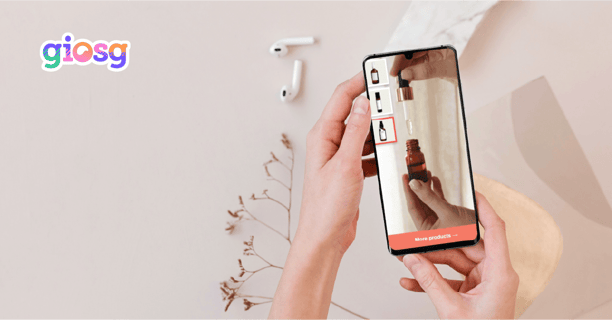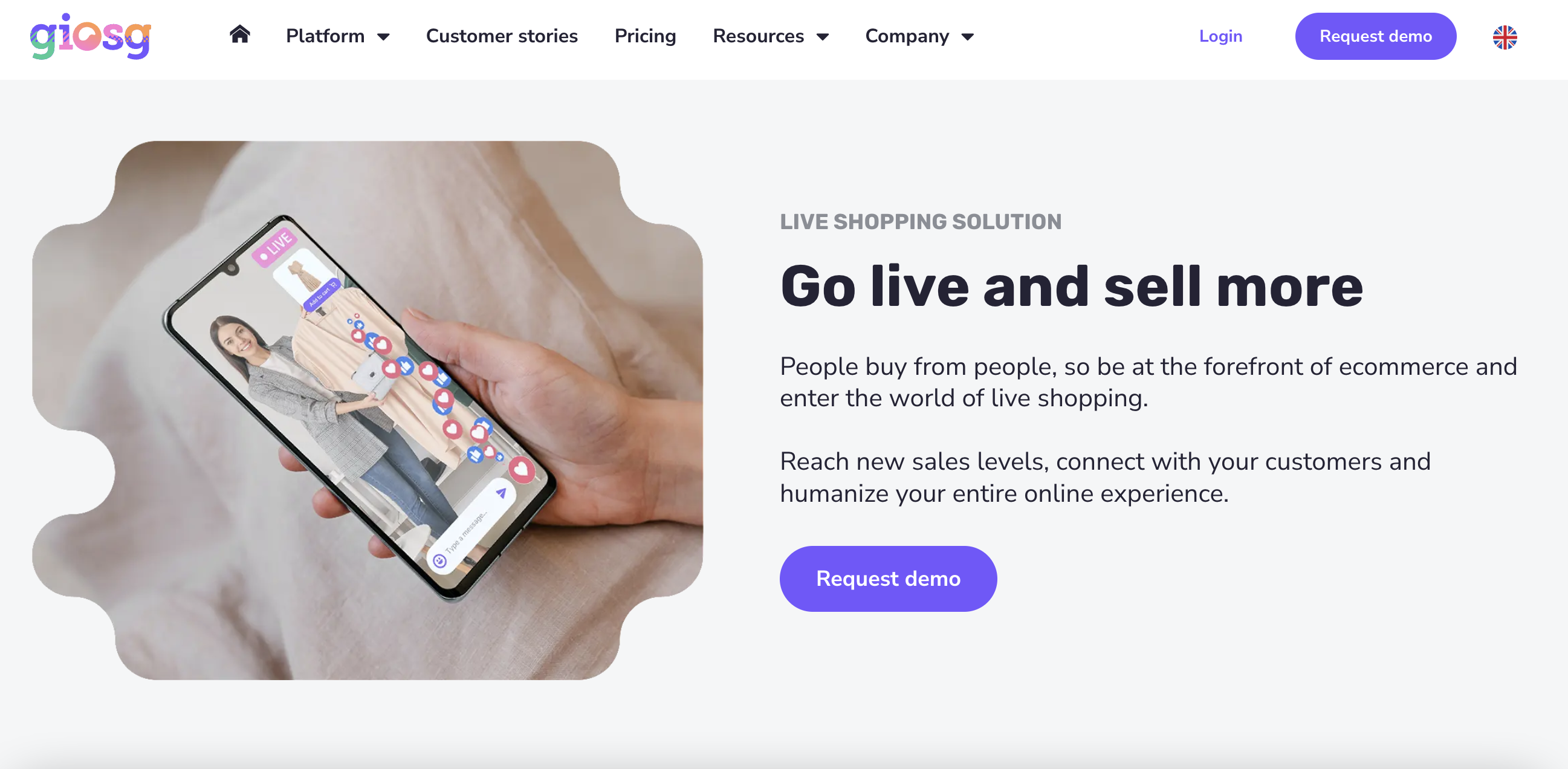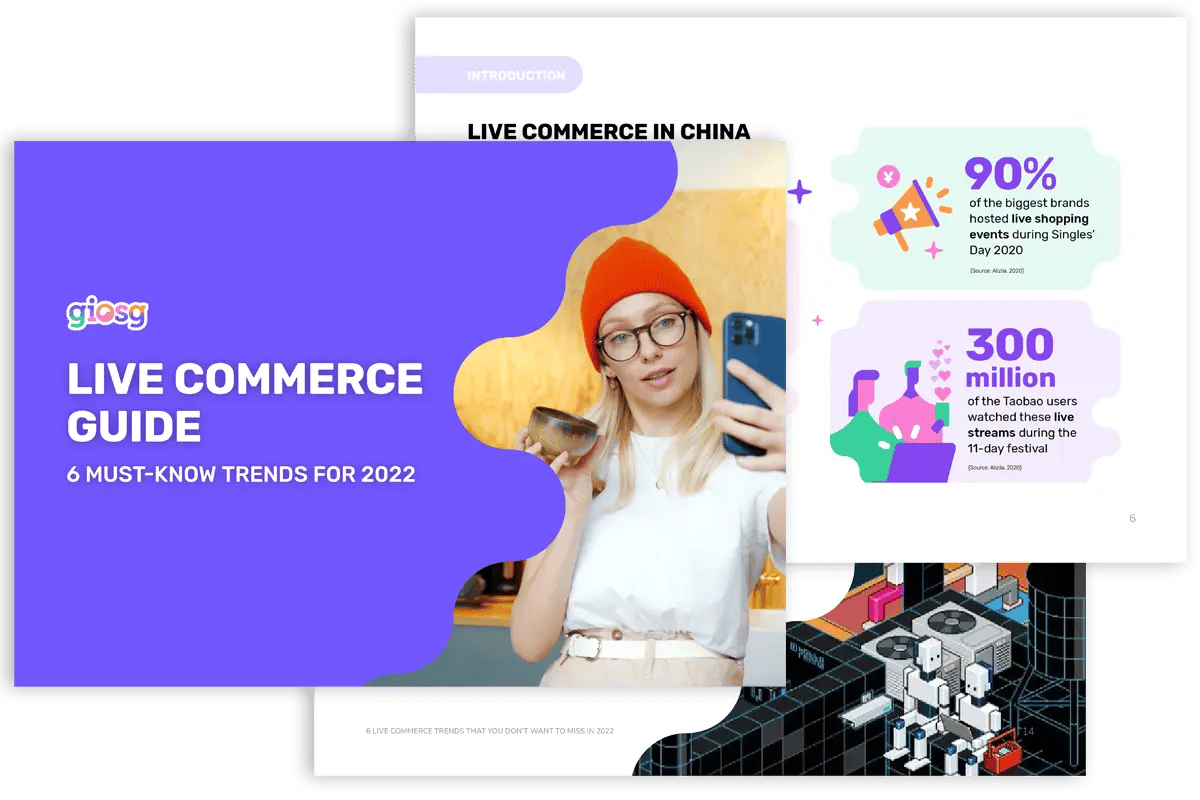Live video shopping is the new kid in town. With titans of industry such as Louis Vuitton, Tiktok and Instagram all hopping on the bandwagon.
In fact, everything in live commerce has been proving to be an attractive market to step into for many businesses.
But staying up to date with all the different platforms can be exhausting, never mind knowing which platform would best suit your needs.
No need to worry! We have you covered. We will be breaking down the pros and cons of the best live shopping platforms out there.

What to know about live video shopping platforms
Before jumping into the deep end, here are some terms to help you understand and navigate this article.
Don’t worry, they are easy to understand.
- Live video shopping on your website is simply the intersection of live video and shopping. It allows sellers, brands and companies to interact with their customers in a live video stream, encouraging them to directly buy items displayed without leaving the stream.
- Software as a service (SaaS) is a method of offering an application over the internet as a service. This means that instead of building and maintaining software, you access it via the internet. No coding needed. Many of the live video shopping platforms on this list are SaaS companies.
- One-to-many live video shopping means streaming to multiple viewers at once. This type of event typically showcases products and features a host, guest appearances, and special promotions.
- One-to-one live video shopping means having a one-on-one session with a single customer. This type of live video shopping is best suited to customers making larger purchases that require professional expertise and insights.
- Embedding allows other websites to host your stream on their website.
11 Best live video shopping platforms
1. Giosg
The first one on the list is giosg.
We are a Finnish SaaS company that offers business tools to create interactive experiences online to connect with customers and boost sales.
giosg is not just a live shopping platform but the ultimate customer experience platform with endless opportunities to transform the online shopping experience.
Giosg has all the features you’d wish for when starting with live shopping:
- one-to-one video calls for personal shopping assistance
- one-to-many live stream shopping for showcasing your products
- and shoppable videos for repurposing your video content and turning them into high-converting ads.
With giosg, you won’t need outside agencies or big production teams, which makes our ecommerce platform especially great for those who are just getting into live shopping solutions and want to test the waters.
Promotional and targeting capabilities make giosg platform stand out.
You can promote your live selling activities via engaging interactive content from pop-ups to gamifications and target your streams, calls, and videos always to the right customers online to ensure engaging shopping experiences.
Cost:
- For information contact sales
Pros:
- Flexible video stream source (Use e.g. YouTube Live, Facebook Live)
- Allows full customization of the solution
- Consultation and dedicated customer support
- Advanced visitor targeting for reaching the right audience
- Allows you to re-purpose video material into shoppable videos
- Full-set of great e-commerce tools, such as chatbots, product recommendation quizzes, targeted pop-ups and live chat
Cons:
- Limited stream management
- Limited video analytics
2. Bambuser
/Bambuser%2011%20Best%20Video%20Live%20Video%20Shopping%20Platforms.jpg?width=1200&name=Bambuser%2011%20Best%20Video%20Live%20Video%20Shopping%20Platforms.jpg)
Image via Bambuser
Second on the list is Bambuser, a SaaS (Software as a Service) provider that offers live video shopping experience for businesses. Bambuser focuses mainly on live streaming, however, they also have the option to post pre-recorded material.
Two options are available. One-to-many, meaning streaming to countless people and one-to-one, which means having a one-on-one with an expert.
One-to-One is more suited for larger purchases. Live video shopping has already been used in the fashion and retail industry.
The platform offers an app on its web page from where you can live stream on your website and share on other social media platforms as well.
Integration with other e-commerce platforms is also possible.
In addition, Bambuser offers a fully equipped studio to film your live video shopping events.
Bambuser’s proven track record is rather impressive and it is a top-of-the-line service.
Cost:
- For information contact sales
Pros:
- Allows you to stream in high-definition video quality
- Allows you to edit, download and re-purpose video material
- Has various integrations to e-commerce platforms
- Chatbot and instant shopping capabilities within live shopping event
Cons:
- Membership is costly.
- No audience targeting
- Live chat feature is not included in the basic package
3. Klarna
/Hero%2011%20Best%20Live%20Video%20Shopping%20Platforms%20(2022).jpg?width=1200&name=Hero%2011%20Best%20Live%20Video%20Shopping%20Platforms%20(2022).jpg)
Image via Klarna
Klarna offers a solution to convert customers who do not have the same confidence to buy as they would in-store.
The Klarna app allows stores to connect to nearby shoppers.
Klarna operates less like a live stream and more as a way to communicate with a shop assistant more humanly.
Klarna offers one-to-many as well as one-to-one.
With Klarna, customers can video chat, text message or chat with a store assistant.
A fresh feature is Klarna’s Stories, which are intended to be similar to Instagram stories.
Short review videos by shop assistants showcasing a particular piece of clothing or an entire outfit.
Cost:
- For more information contact sales
Pros:
- Keeping in touch with your customer via Live Chat
- Allows you to contact stores with three options: Video, Text and Chat
- Allows you to integrate with Shopify
- Video Chat with in-store assistant
- Flexible payment method
Cons:
- Doesn’t allow audience targeting
- Learning curve to get used to software
4. Streams.live
/Streams.live%2011%20Best%20Video%20Live%20Video%20Shopping%20Platforms%20(1).jpg?width=1200&name=Streams.live%2011%20Best%20Video%20Live%20Video%20Shopping%20Platforms%20(1).jpg)
Image via Streams.live
Streams.live allows customers to buy products straight from a live video session. Comment sections help keep the experience interactive.
The platform offers iOS app as well as their own web page from where you can stream live on your own web page and share to other social media platforms.
Streams.live is perhaps very similar to Bambuser, with many of the same features. However, their standout feature is their platform that allows users to sell NFT’s via live video.
An NFT stands for non-fungible token. Non-fungible: meaning it is unique and cannot be replaced.
Something to consider for this platform is that the more viewers you have the more expensive it will be.
Cost:
- Personal: Free for 5 live shopping products and 60 streaming minutes
- Pro: $299/month for 20 live shopping products and 25.000 streaming minutes
- Enterprise: Unlimited live shopping products and 250.000 streaming minutes, contact sales for pricing.
- For more information contact sales
Pros:
- Allows for the sale of NFT’s
- Coding is not required
- Embedding stream to your own website
- Integrate with Shopify
- Live chat discussions and instant shop capabilities within shopping event
- Upload options pre-recorded videos
Cons:
- No video archive
- No audience targeting
5. Facebook Live
/Facebook%20Live%2011%20Best%20Video%20Live%20Video%20Shopping%20Platforms.jpg?width=1200&name=Facebook%20Live%2011%20Best%20Video%20Live%20Video%20Shopping%20Platforms.jpg)
Image via Facebook
Facebook, which was recently rebranded as Meta, now offers a live shopping feature that can be accessed via the Facebook Business page.
This feature is the next evolution of Facebook’s Marketplace platform, which originally only allowed sellers to post pictures of products.
The platform allows you to stream on Facebook to current audiences, as well as embedding to other social media platforms.
However, when a Facebook Live feed is embedded onto your own website viewers cannot comment or interact with the stream.
Customer data is limited so you would have considerably less data than if the customer would have purchased from your own website.
Cost:
- The selling fee is 5% per shipment or a flat fee of $0.40 for shipments of $8.00 or less.
Creating and operating a shop is free.
Pros:
- Analytics available via Facebook for Business Page
- Facebook notifies fans when live shopping stream is beginning
- Live video shopping sessions are archived and can be used at a later stage
- Free to use
Cons:
- Not intuitive user experience
- Viewers cannot interact with video once embedded on your own site
- Facebook Ads will appear on the screen
- No 1-to-1 video options
- No targeting (addresses all viewers)
- Harder to drive customers to own website
6. Instagram Live
/Instagram%20Live%2011%20Best%20Video%20Live%20Video%20Shopping%20Platforms.jpg?width=1200&name=Instagram%20Live%2011%20Best%20Video%20Live%20Video%20Shopping%20Platforms.jpg)
Image via Instagram
Instagram Live shopping and Facebook Live shopping both share the Facebook Business Page platform. This means that many of the features, and issues, are shared by both platforms.
Obstacles include Instagram retaining all customer data that is not necessary for shipping. This makes building customer trust and retention harder - as well as building a brand.
In-app purchases ensure that traffic is not being driven to your own website. This may be ideal for small businesses that don’t have their own web interfaces, but for larger businesses, Instagram’s checkout margin for using their platform may be a factor to avoid.
Cost:
- The selling fee is 5% per shipment or a flat fee of $0.40 for shipments of $8.00 or less.
Creating and operating a shop is free.
Pros:
- Offers in-app purchases
- Access to analytics via Facebook’s Business Page
- Ability to take advantage of Facebook’s Business Page
- Easy to collaborate with other content creators
- Free to use
Cons:
- Mobile-only – does not support third-party video streaming service.
- Harder to drive customers to own website
- In-app purchases (does not drive traffic to own website)
- No 1-to-1 video options
- The selling fee of 5% per shipment is a margin to consider
7. Channelize
/Channelize%2011%20Best%20Live%20Video%20Shopping%20Platforms%20(2022).jpg?width=1200&name=Channelize%2011%20Best%20Live%20Video%20Shopping%20Platforms%20(2022).jpg)
Image via Channelize
Channelize.io platform enables e-commerce businesses to leverage the power of live video shopping.
A live shopping experience that lets you host live video within your apps and own website. Channelize has experience in a lot of different industries that gives it credibility.
Cost:
- Free but very limited. Add-ons starting at $49/month
- For more information contact sales
Pros:
- Live chat tools
- Proven track record in various industries
- Integration with other e-commerce sites (Shopify)
- Unlimited buyer audience
- Great customer support
Cons:
- Limited changes to user interface
- Can get costly with additional add-ons
8. Live Scale
/Live%20Scale%20Live%2011%20Best%20Video%20Live%20Video%20Shopping%20Platforms.jpg?width=1200&name=Live%20Scale%20Live%2011%20Best%20Video%20Live%20Video%20Shopping%20Platforms.jpg)
Image via Live Scale
Livescale is a cloud-based live stream shopping software that uses interactive content and gamification to help retailers and e-commerce enterprises increase buyer engagement.
Customers can make purchases from live videos using the application's in-video checkout feature. Team members can connect with purchasers, block users, modify or remove messages, and delete comments using Livescale's chat moderator module.
Livescale integrates with Shopify, allowing users to analyse product feeds, as well customer information.
Cost:
- It depends on your company needs, contact sales
Pros:
- Third-party integration
- Seamless Checkout V
- In-video purchases
- Brand-owned experience control V
- Live chat capabilities
Cons:
- Platform only supported on the web, not mobile apps
9. Smartzer
/Smartzer%20Live%2011%20Best%20Video%20Live%20Video%20Shopping%20Platforms.jpg?width=1200&name=Smartzer%20Live%2011%20Best%20Video%20Live%20Video%20Shopping%20Platforms.jpg)
Image via Smartzer
Smartzer helps marketers with making videos interactive and shoppable. Hotspots are added to video to create pop-out carts wherein customers can view the entire outfit shown in the video or stream. These hotspots help improve click-through rates.
Smartzer is perhaps unique, they offer short interactive videos, livestream and offers CRM tools.
Cost:
- Subscription-based
- For more information contact sales
Pros:
- Hotspots that open pop out carts, added to video/stream content
- Customer engagement data from viewers
- Repurpose live video shopping events
- Embed to e-commerce platforms and social media
- Instant add to cart
- Sleek interface/look
Cons:
- No WordPress integration
10. NTWRK
/NTWRK%20Live%2011%20Best%20Video%20Live%20Video%20Shopping%20Platforms.jpg?width=1200&name=NTWRK%20Live%2011%20Best%20Video%20Live%20Video%20Shopping%20Platforms.jpg)
Image via NTWRK
NTWRK prioritizes exclusive product launches from world-renowned artists, brands and influencers for a global audience.
The platform is a mobile-first living video shopping platform, with upcoming drops of various products displayed on their website.
NTWRK is more inclined towards customers at the bottom of the funnel with many products being rare and rather pricey – high-end fashion. Before being able to sell on the platform, NTWRK needs to grant you access, ensuring that they feature only high-quality creators and influencers.
NTWRK also hosts daily episodes where they show different products from various sellers. These episodes usually last 15min with lots of content packed into a small time frame.
The platform is geared towards a younger audience looking for scarce coveted products and are willing to pay a big margin.
Cost:
- For information contact sales
Pros:
- Hosts virtual festivals
- Sleek interface
- Established market for exclusive products
- Hosts sale of NFT’s
Cons:
- Cannot embed to other platforms
- App based
- No data on customer activity
11. Conferwith
/Conferwith%2011%20Best%20Video%20Live%20Video%20Shopping%20Platforms.jpg?width=1200&name=Conferwith%2011%20Best%20Video%20Live%20Video%20Shopping%20Platforms.jpg)
Image via Conferwith
Conferwith is a video commerce platform offering real-time advice to customers via video. The platform is focused on one-to-one interactions, as opposed to a one-to-many interaction.
Additionally, the platform is geared towards customers looking to make larger purchases.
Functioning as a browser-based platform, Conferwith’s highlight feature is that it allows users and customers to add items into a “shared basket”.
Cost:
- For information contact sales
Pros:
- Specialise in one-to-one live video shopping
- Easy integration
- Diverse client base from different industries
Cons:
- “Shared basket” feature may put pressure on shoppers to buy something they don’t want
“The Proof is in the Pudding”
Navigating different live video shopping platforms can be overwhelming. Figuring out which platform best suits your business’ needs is no easy task.
Only you can truly know what will best meet your business needs.
Many of the live video shopping platforms mentioned have some sort of free trial, so you can try out what fits for free.
That being said, here’s a free guide live commerce trends to download.
If you want to learn more about live video shopping and the live commerce industry, download our free Live Commerce Guide here.

